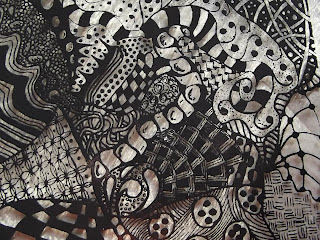I will be using a screen that is already made up (from my pottery/clay screening class I took at Pine Tree Potters) (I will be soone showing how to make one of these) and using a glass paint - Reusche Black Trace DE401 mixed with Thompson Screening Medium (Misible with water - which means easy water clean up )
First I put together my screen printing assembly - a wood back (got at curry's its a light plywood type box frame but I am using the back ) assembled my screen printing hinges (again curry's or Dick Blick in the States)
When assembled it gives space between the hinge and the screen of approx 3mm - my glass is approx 2mm thick. Once you have the hinges on the back - These hinges allow for you to swap out screens easily
I block off around the image with painters blue tape for easy clean up later and it gives me a space to keep the paint when screening as a rest space. This makes for easy clean up after
(space between the hinge connects top and bottom have the 3mm space which allows for a sheet of glass to sit between without crushing )
When I tape the back board - I put a white sheet of paper in the centere so I can see the image after screening
Once I have it all blocked off I make my paint.
Using Reusche Black Trace DE401 - comes in various sizes - and you do not have to use black - there are lots of colors- and you do not have to use Reusche there are other enamels out there. I'll be using some Thompson enamels shortly
and the A14 Thompson Screening Medium
I mix with a pallet knife till it is sort of like a syrup - not too thin and not too thick - hard to describe - too watery and it will pool on the glass - too thick and you will not get it through the screen. If you make it too thin - it will pool and all you have to do is clean up and start over. - too thick and your images are not clear and may be missing in spots - clean up and start over.
I place a clean sheet of glass on the back board - I lower the top and make sure that where the edges meet I have tape over - this just ensures I am not pushing paint where there is no glass. and ensuring I will not tear the screen by pushing on the edge. The tape re-enforces the area. (most cut sheet is the same size so you do not have to do this for every sheet of glass. I try to position the white sheet so its within the sheet of glass.

Once mixed I pour a line at the bottom of my screen. Just pour onto the tape - this is what I meant as a resting spot for the paint.
I take my squeegee (which needs to be slightly wider than your image) and lightly run it over the screen (not touching the glass ) this is called flooding the screen
(see my hand holding up the screen from the glass)
I put the screen down on top of the glass (and holding it down tight) I push down and draw down the squeegee to the bottom in one motion.
Holding the squeegee and the frame- the screen will lift from the glass and then I slowly lift and pull out the glass and put to the side .
I hold up the screen frame and flood the screen again. (pulling the squeegee to the top) (add more paint if you do not have enough to flood the screen completely. and repeat.
Because its glass paint it may clog and after only a couple of screenings you may have to clean and repeat the process.
I only had enough leftover paint to do two screenings. Which I was happy with . This will make me about 35 pieces for my lampwork beads
I sat out to dry - takes quite a while as the screening medium is like an oil - so I set in the sun they will dry - - when wet they are shiny - when dry they are a matte finish to speed up drying I use a hair dryer or a kiln on low - or my electric fryer as its like a huge cup warmer - I want to cut into pieces and fire - or I could get out my big kiln and fire as one big piece and cut later - choices - (if not dry enough before firing it can bubble and pop off )
Clean up is easy - just use water .
I love my spray hose that screws onto the tap (if you have a tap that you can screw on ) or a hose will do just as well -just not too powerful or you could ruin your screen) it cleans up the screen rather well - just enough pressure to push the paint out
Very happy with the results - clean and crisp
Best part is if you mess up you just wash the glass off and start again















































.jpg)

